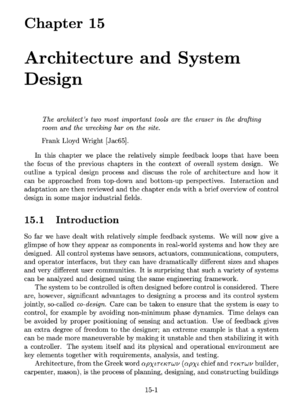Architecture and System Design
Jump to navigation
Jump to search
| Prev: Fundamental Limits | Chapter 15 - Architecture and System Design | Next: Bibliography |
In this chapter we place the relatively simple feedback loops that have been the focus of the previous
Contents
- Introduction
- System and Control Design
- Top-Down Architectures
- Layered Architectures for Control
- Online Optimization
- Discrete-decision making and supervisory control
- Linking Continuous and Discrete Controllers
- Model Checking and Program Synthesis
- Bottom-Up Architectures
- Cascade Control -- Several Sensors
- Mid-Range Control -- Many Actuators
- Selector Control -- Equipment Protection
- Internal Model Control -- Disturbance Observer
- The Smith Predictor -- Phase Advance
- Complementary Filtering -- Sensor Fusion
- Extremum Seeking or Self-Optimization
- Interaction
- The Relative Gain Array
- Parallel Systems
- Adaptation and Learning
- Adaptive Control
- Learning
- Neural Networks
- Deep Learning
- Control Design in Common Application Fields
- Aerospace -- High Performance Systems and Highly Skilled Users
- Automotive -- Complex Systems Used by Ordinary People
- Process Industry -- Complex Systems with Many Different Users
- Telecommunication -- Billions of Systems
- Further Reading
